1994 CHEVROLET S10 air condition
[x] Cancel search: air conditionPage 242 of 340
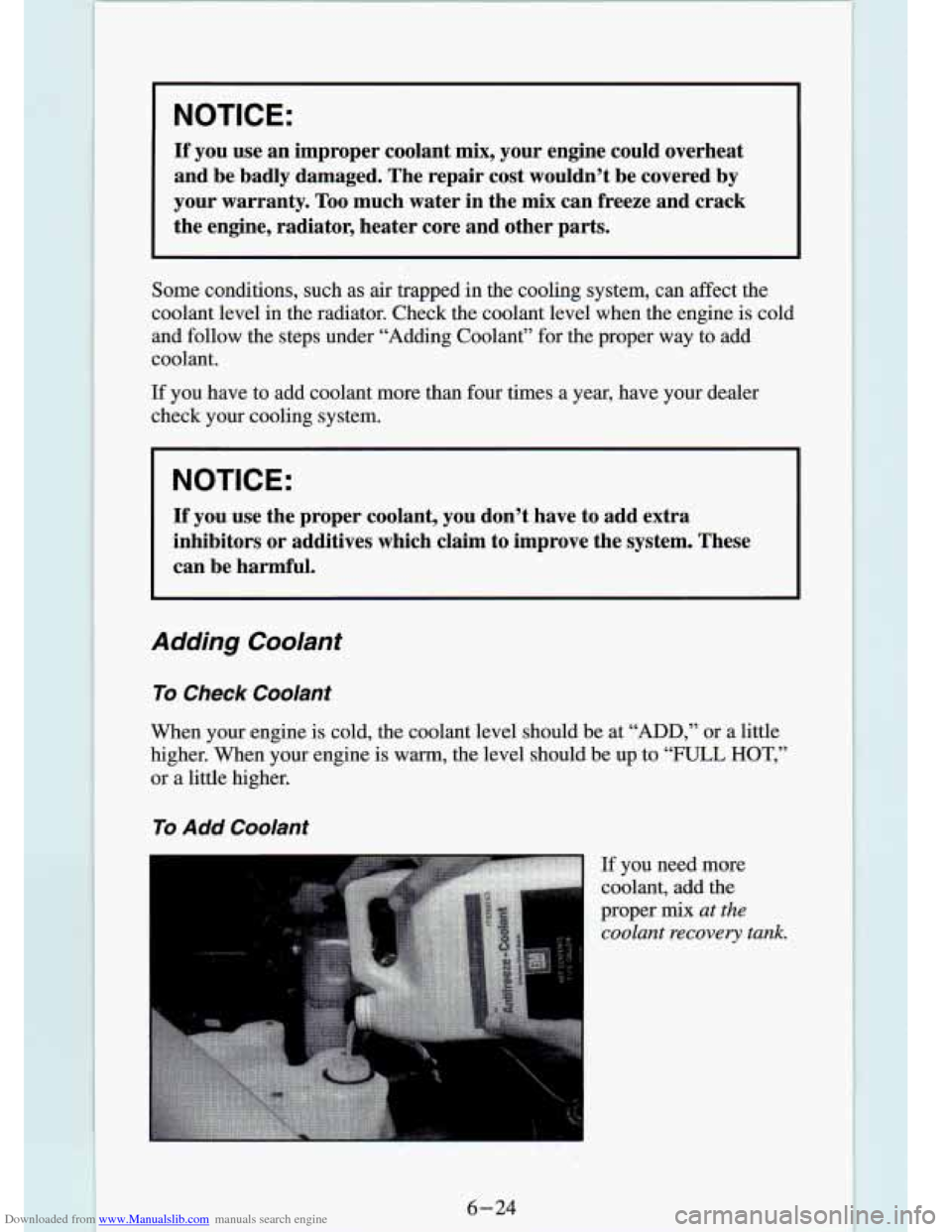
Downloaded from www.Manualslib.com manuals search engine I NOTICE:
If you use an improper coolant mix, your engine could overheat
and be badly damaged. The repair cost wouldn’t be covered by
your warranty. Too much water in the
mix can freeze and crack
the engine, radiator, heater core and other parts.
Some conditions, such as air trapped in the cooling system, ca\
n affect the
coolant level in the radiator. Check the coolant level when th\
e engine
is cold
and foilow the steps under “Adding Coolant” for the proper way to add
coolant.
If you have to add coolant more than four times a year, have your dealer
check your cooling system.
I NOTICE:
If you use the proper coolant, you don’t have to add extra
inhibitors or additives which claim to improve the system. These
can be harmful.
Adding Coolant
To Check Coolant
When your engine is cold, the coolant level should be at “ADD,” or a little
higher. When your engine is warm, the level should be up to
“FULL HOT,”
or a little higher.
To Add Coolant
I
If you need more
coolant, add the
proper
mix at the
coolant recovery tank.
6-24
Page 246 of 340
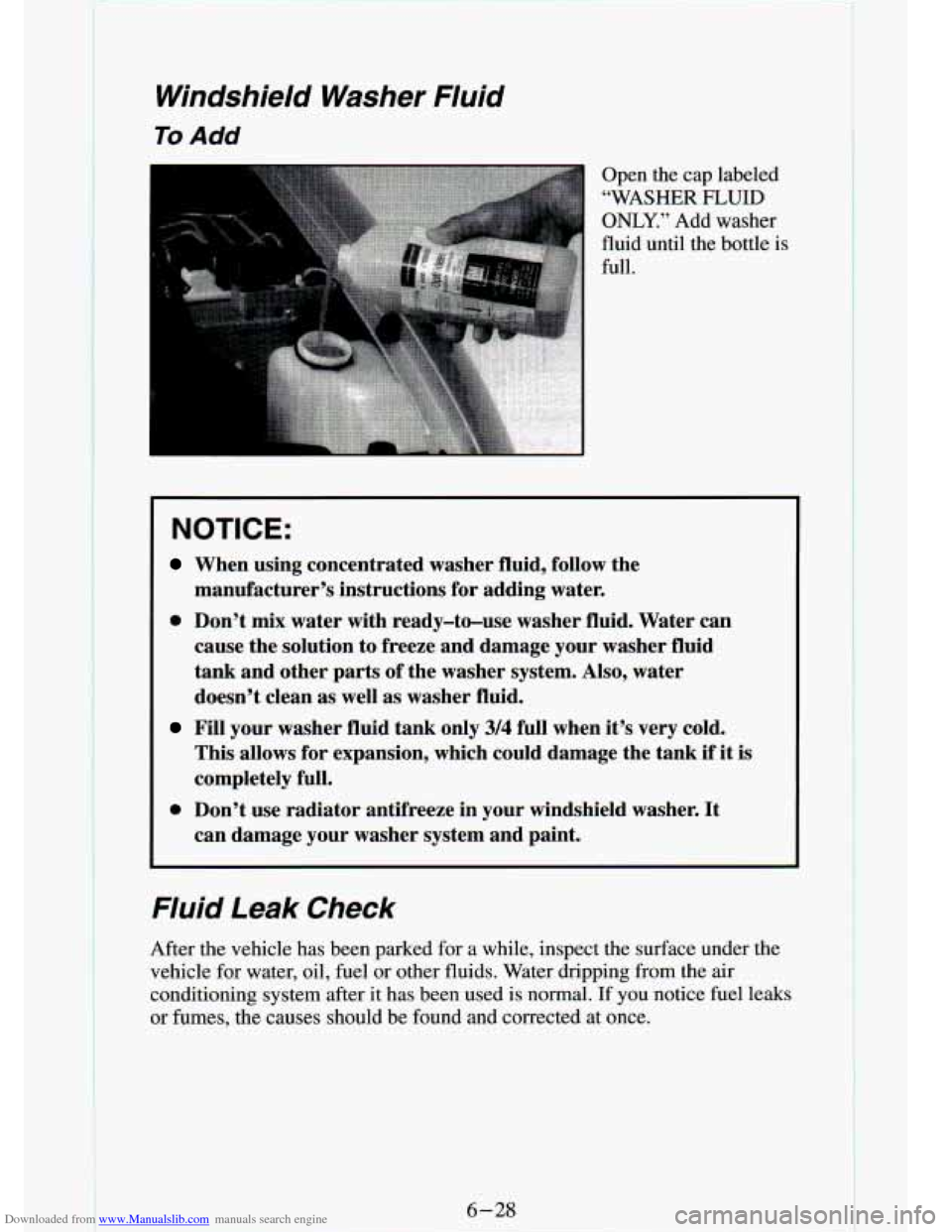
Downloaded from www.Manualslib.com manuals search engine Windshield Washer Fluid
To Add
I Open the cap labeled
“WASHER
FLUID
ONLY.” Add washer
fluid until the bottle
is
full.
NOTICE:
When using concentrated washer fluid, follow the
manufacturer’s instructions for adding water.
0 Don’t mix water with ready-to-use washer fluid. Water can
cause the solution
to freeze and damage your washer fluid
tank and other parts
of the washer system, AIso, water
doesn’t clean as well as washer fluid.
Fill your washer fluid tank only 3/4 full when it’s very cold.
This allows for expansion, which could damage the tank
if it is
completely full.
can damage your washer system and paint.
0 Don’t use radiator antifreeze in your windshield washer. It
Fluid Leak Check
After the vehicle has been parked for a while, inspect the su\
rface under the
vehicle for water, oil, fuel or other fluids. Water dripping from the air
conditioning system after it has been used is normal. If you notice fuel leaks
or fumes, the causes should be found and corrected at once.
6-28
Page 249 of 340
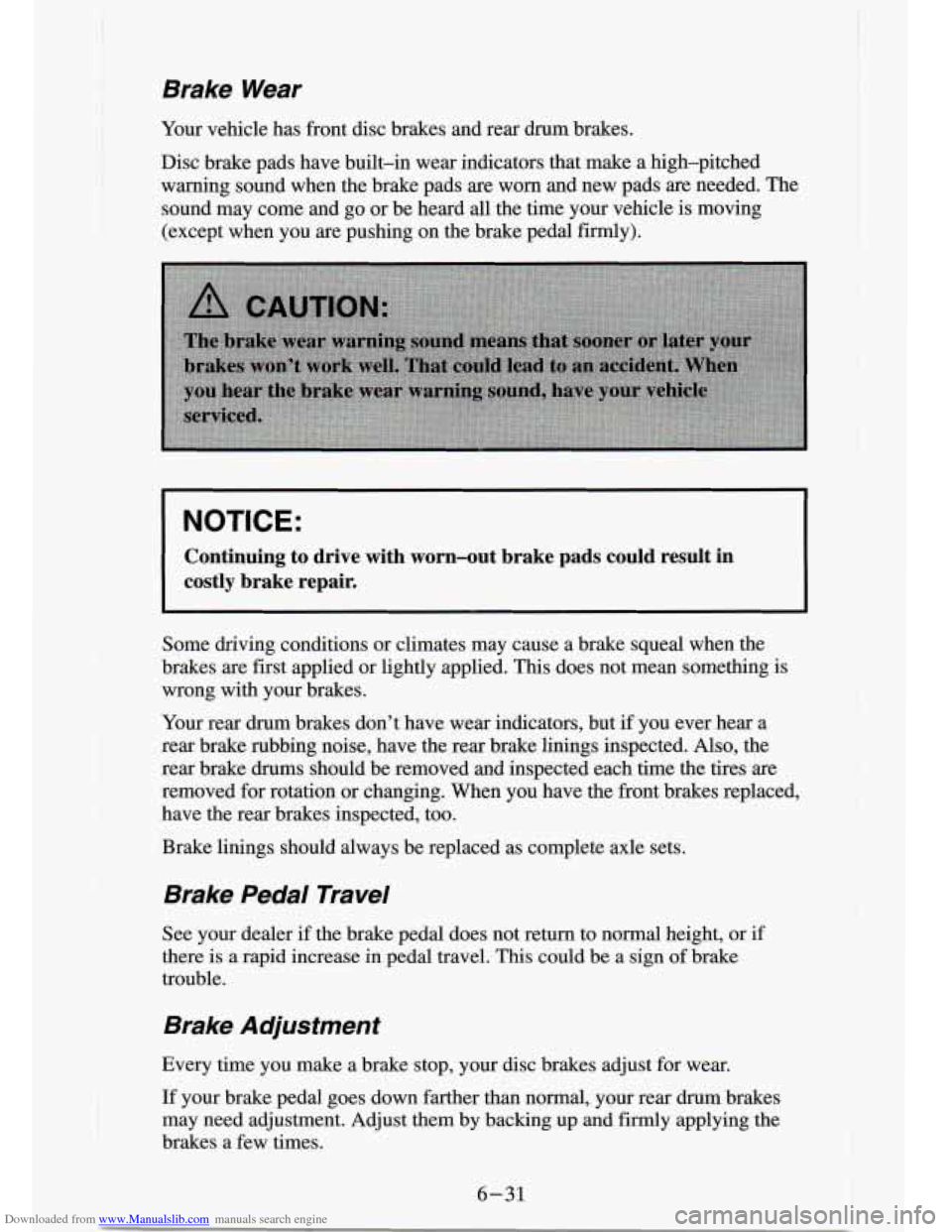
Downloaded from www.Manualslib.com manuals search engine Brake Wear
Your vehicle has front disc brakes and rear drum brakes.
Disc brake pads have built-in wear indicators that make a high\
-pitched warning sound when the brake pads are worn and new pads are \
needed. The
sound may come and go or be heard
all the time your vehicle is moving
(except when you -are pushing on the brake pedal
firmly).
I NOTICE:
I
Continuing to drive with worn-out brake pads could result in
costly brake repair.
Some driving conditions or climates may cause a brake squeal w\
hen the
brakes are first applied or lightly applied. This does not mean something is
wrong with your brakes.
Your rear
drum brakes don’t have wear indicators, but if you ever hear a
rear brake rabbing noise, have the rear brake linings inspected. Also, the
rear brake drums should be removed and inspected each time the\
tires itre
removed for rotation or changing. When you have the front brakes replaced,
have the rear brakes inspected, too.
Brake linings should always be replaced
as complete axle sets.
Brake Pedal Travel
See your dealer if the brake pedal does not return to normal height, o\
r if
there is a rapid increase in pedal travel. This could be a sign of brake
trouble.
Brake Adjustment
Every time you make a brake stop, your disc brakes adjust for wear.
If your brake pedal goes down farther than normal, your rear drum brakes
may need adjustment. Adjust them by backing up and
firmly applying the
brakes a few times.
6-31
Page 251 of 340
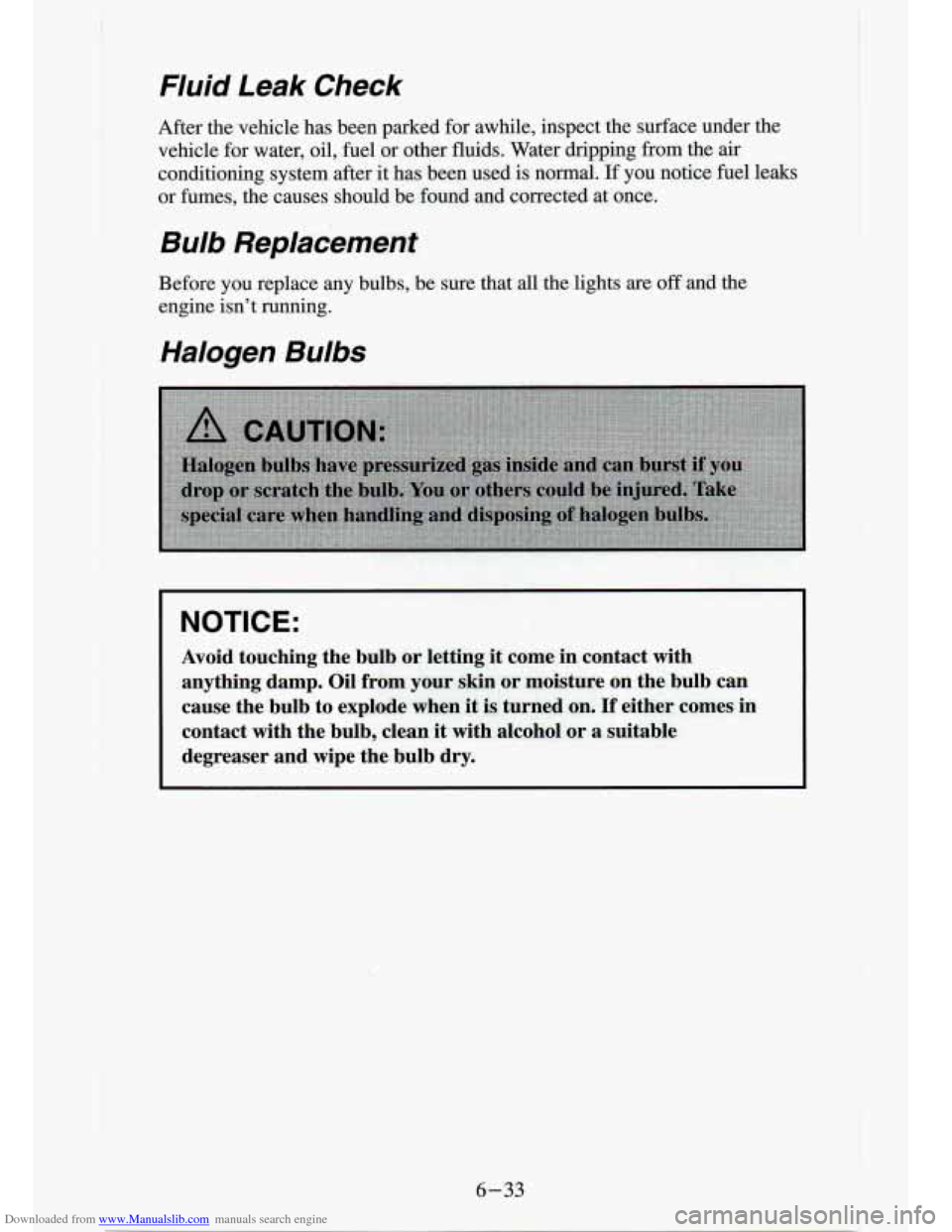
Downloaded from www.Manualslib.com manuals search engine Fluid Leak Check
After the vehcle has been parked for awhile, inspect the surface under the
vehicle
for water, oil, fuel OX other fluids. Water dripping from the air
conditioning system after it has been used is normal. If you notice fuel leaks
or fumes, the causes should be found and corrected at once.
Bulb Replacement
Before you replace any bulbs, be sure that all the lights are off and the
engine isn’t running.
Halogen Bulbs
NOTICE:
Page 260 of 340
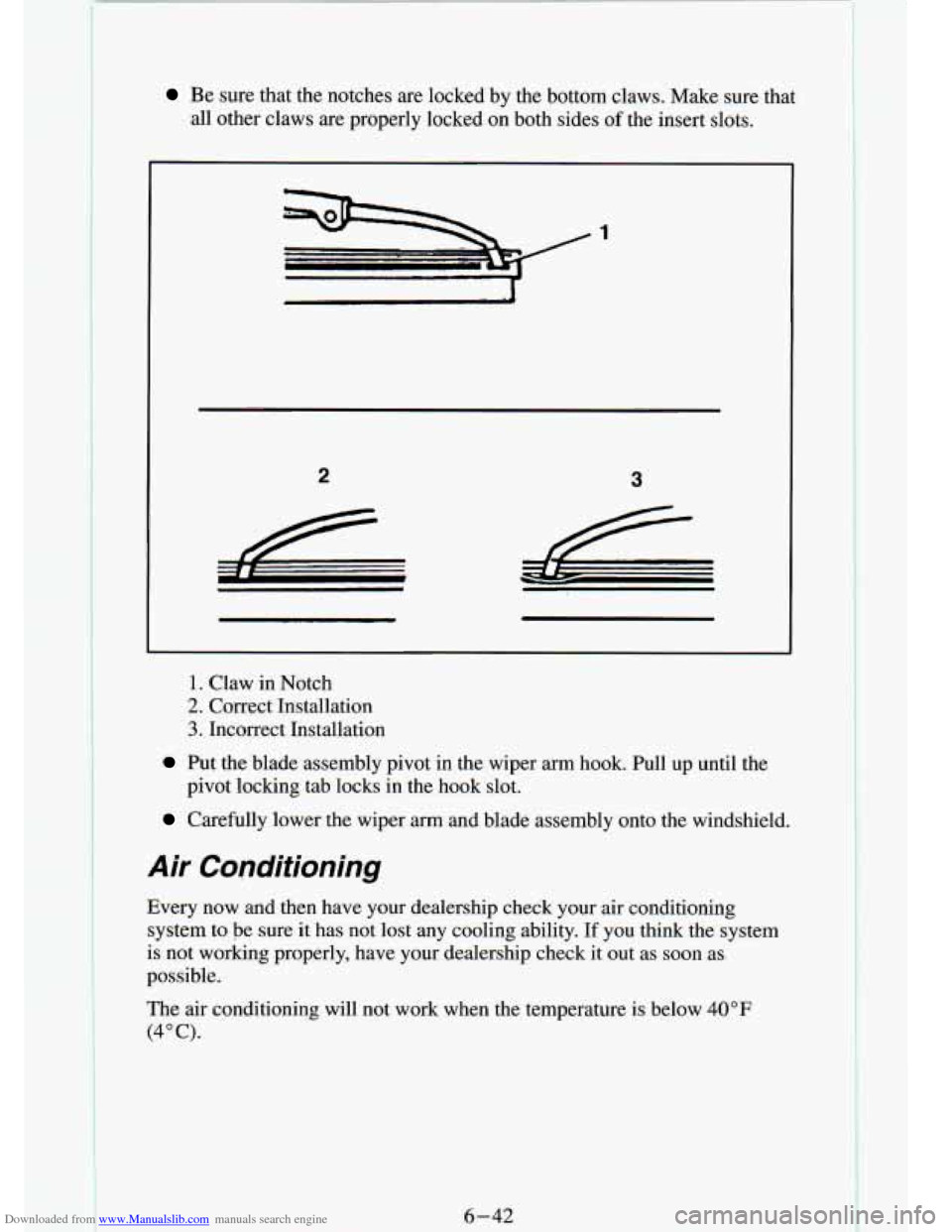
Downloaded from www.Manualslib.com manuals search engine Be sure that the notches are locked by the bottom claws. Make sure that
all other claws are properly locked on both sides of the insert slots.
2
1. Claw in Notch
2. Correct Installation
3. Incorrect Installation
Put the blade assembly pivot in the wiper arm hook. Pull up until the
Carefully lower the wiper arm and blade assembly onto the wind\
shield.
pivot locking tab locks
in the hook slot.
Air Conditioning
Every now and then have your dealership check your air conditi\
oning
system to be sure it has not lost any cooling ability.
If you think the system
is not working properly, have your dealership check it out as soo\
n as
possible.
The air conditioning will not work when the temperature is
- - v 40°F
(4°C).
Page 275 of 340
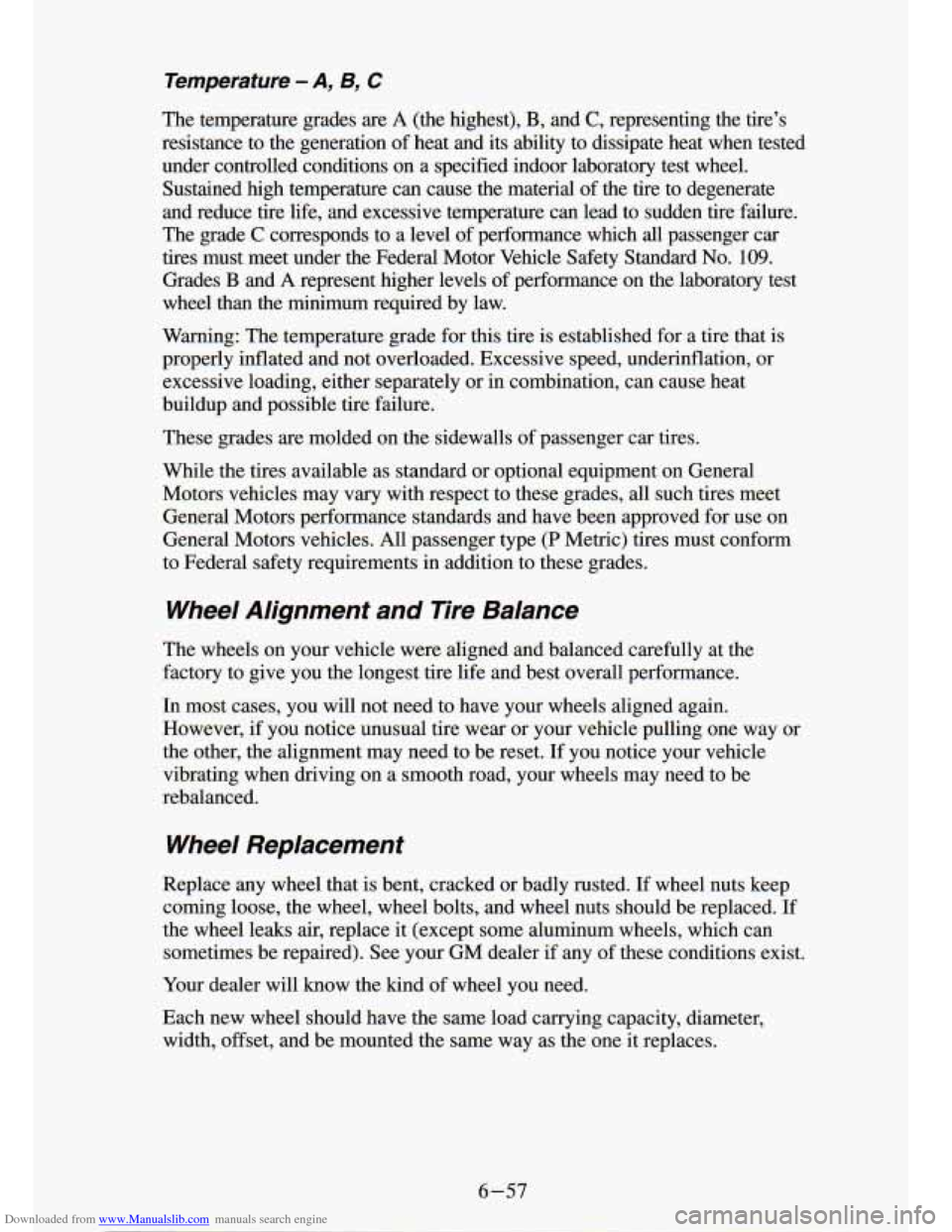
Downloaded from www.Manualslib.com manuals search engine Temperature -A, By C
The temperature grades are A (the highest), B, and C, representing the tire’s
resistance to the generation of heat and its ability
to dissipate heat when tested
under controlled conditions on a specified indoor laboratory tes\
t wheel.
Sustained high temperature can cause the material of the tire to degenerate
and reduce tire life, and excessive temperature can lead to su\
dden tire failure.
The grade
C corresponds to a level of performance which all passenger car
tires must meet under the Federal Motor Vehicle Safety Standard\
No. 109.
Grades B and A represent higher levels of performance on the laboratory test
wheel than the minimum required by law.
Warning: The temperature grade for
this tire is established for a tire that is
properly inflated and not overloaded. Excessive speed, underinfla\
tion, or
excessive loading, either separately or in combination, can cause heat
buildup and possible tire failure.
These grades are molded on
the sidewalls of passenger car tires.
While the tires available as standard or optional equipment on General
Motors vehicles may vary with respect to these grades, all such tires meet
General Motors performance standards and have been approved for use on
General Motors vehicles. All passenger type
(P Metric) tires must conform
to Federal safety requirements in addition to these grades.
Wheel Alignment and Tire Balance
The wheels on your vehicle were aligned and balanced carefully at the
factory to give you the longest tire life and best overall performance.
In most cases, you will not need to have your wheels aligned again.
However,
if you notice unusual tire wear or your vehicle pulling one way \
or
the other, the alignment may need to be reset. If you notice your vehicle
vibrating when driving
on a smooth road, your wheels may need to be
rebalanced.
Wheel Replacement
Replace any wheel that is bent, cracked or badly rusted. If wheel nuts keep
coming loose, the wheel, wheel bolts, and wheel nuts should be replaced.
If
the wheel leaks air, replace it (except some aluminum wheels, \
which can
sometimes be repaired). See your GM dealer if any of these conditions exist.
Your dealer will know the kind of wheel you need,
Each new wheel should have the same load carrying capacity, diameter,
width, offset, and be mounted the same way as the one it replaces.
6-57
Page 285 of 340
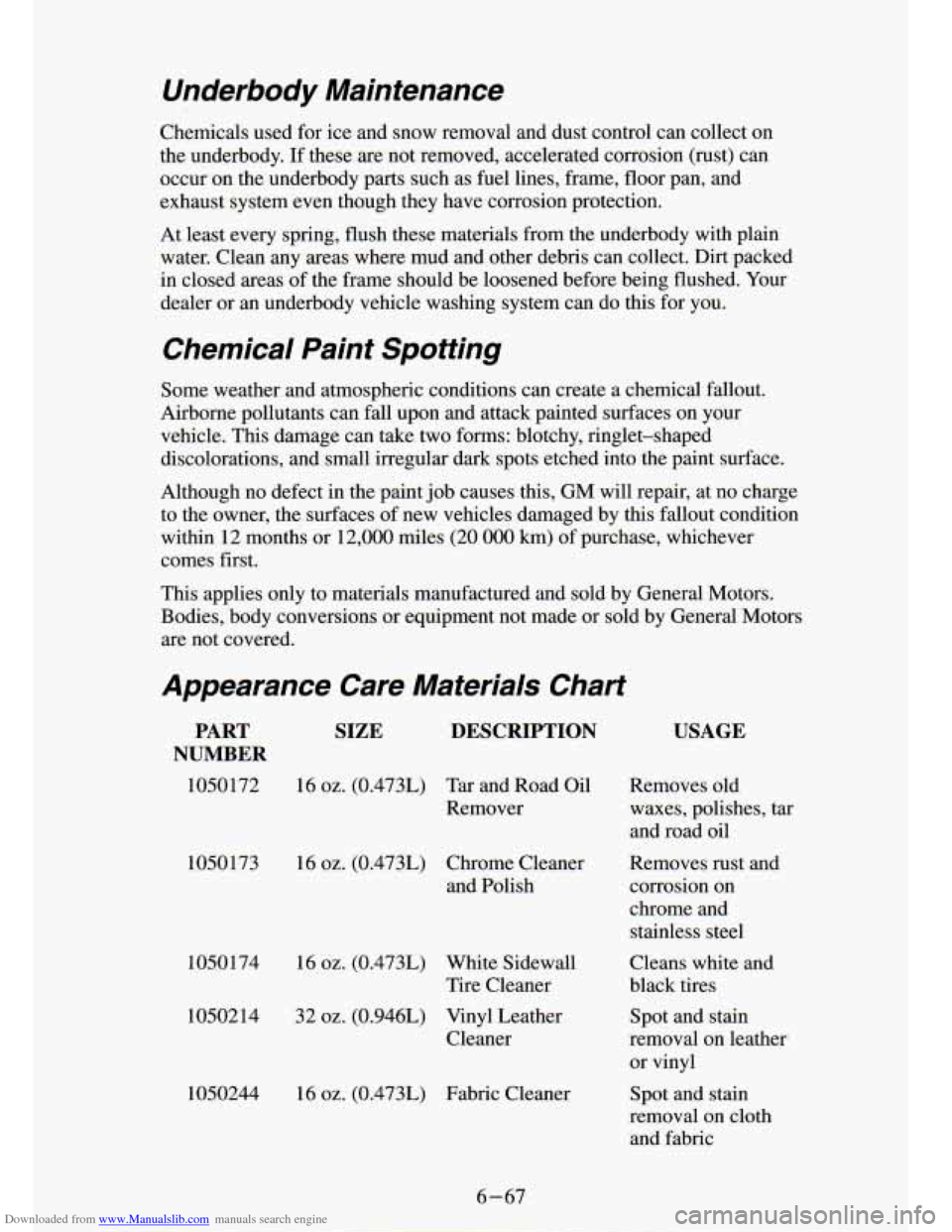
Downloaded from www.Manualslib.com manuals search engine Underbody Maintenance
Chemicals used for ice and snow removal and dust control can collect on
the underbody. If these are not removed, accelerated corrosion \
(rust) can
occur on the underbody parts such as fuel lines, frame, floor \
pan, and
exhaust system even though they have corrosion protection.
At least every spring, flush these materials from the underbody\
with plain water. Clean any areas where mud and other debris can collect.\
Dirt packed
in closed areas of the frame should be loosened before being flushed.
Your
dealer or an underbody vehicle washing system can do this for you.
Chemical Paint Spotting
Some weatherand atmospheric conditions can cre; a chemical fallout.
Airborne pollutants can fall upon and attack paintea surfaces on your
vehicle. This damage can take two forms: blotchy, ringlet-shape \
discolorations, and small irregular dark spots etched into the \
paint
sur - :e.
Although no defect in the paint job causes
this, GM will repair, at no charge
to the owner, the surfaces of new vehicles damaged by this fallout condition
within 12 months or 12,000 miles (20
000 km) of purchase, whichever
comes first.
-'
This applies only to materials manufactured and sold by General Motors.
Bodies, body conversions or equipment not made or sold by Gene\
ral Motors are not covered.
Appearance Care Materials Chart
PART SIZE DESCRIPTION
NUMBER
1050172 16 oz. (0.473L) Tar and Road Oil Removes old
Remover waxes, polishes, tar and road oil
16
oz. (0.473L) Chrome Cleaner Removes rust and and Polish corrosion on
chrome and
sta ess steel
1050173
1050174 16
oz. (0.473L) White Sidewall
Tire Cleaner
1050214 32
oz. (0.946L) Vinyl Leather
Cleaner
1050244 16
oz. (0.473L) Fabric Cleaner
USAGE
Spot and stain
removal on leather
or vinyl
Spot and stain
removal on cloth and fabric
6- 67
Page 296 of 340

Downloaded from www.Manualslib.com manuals search engine 4.3L (Z)
PF52
A773C CV789C .CR43TSM
GF48
1
RC36
4.3L (W)
PF52
A1163C cv774c .CR43TSM
GF481
RC36
Service Replacement Part and Filter
Recommendations
Engine (VIN) 2.2L (4)
Oil Filter PF47
Air Cleaner Filter A1163C
PCV Valve cv9ooc
Spark Plugs* AC908
Fuel Filter GF48
1
Radiator Cap RC36
*Use copper-cored resistor type spark plugs.
Air Conditioning Refrigerants
Not all air conditioning refrigerants are the same. If the air conditioning
system
in your vehicle needs refrigerant, be sure the proper refrigerant is
used. If you’re not sure, ask your
GM dealer. For additional information, see
your “Warranty and Owner Assistance Information” booklet.
Air Conditioning Refrigerant Capacity
TYPE SYSTEM QUANTITY*
R-l34a c-60 30 oz. (35 kg)
*All
q1 Les are approximate. ..
NOTICE:
R-134a refrigerant is not compatible with R-12 refrigerant in
an air conditioning system. R-12 in an R-134a system will caus\
e
compressor failure, refrigerant oil sludge,
or poor air
conditioning system performance.